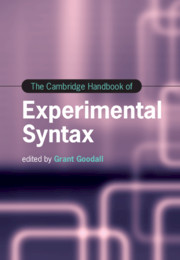Book contents
- The Cambridge Handbook of Experimental Syntax
- The Cambridge Handbook of Experimental Syntax
- Copyright page
- Contents
- Figures
- Tables
- Contributors
- Introduction
- Part I General Issues in Acceptability Experiments
- Part II Experimental Studies of Specific Phenomena
- Part III Experimental Studies of Specific Populations and Language Families
- 14 Acceptability Studies in L2 Populations
- 15 Judgments of Acceptability, Truth, and Felicity in Child Language
- 16 Acceptability and Truth-Value Judgment Studies in East Asian Languages
- 17 Acceptability Experiments in Romance Languages
- 18 Acceptability Studies in (Non-English) Germanic Languages
- 19 Acceptability Studies in Semitic Languages
- 20 Experimental Syntax and Slavic Languages
- 21 Acceptability Judgments in Sign Linguistics
- Part IV Experimental Syntax beyond Acceptability
- Index
- References
18 - Acceptability Studies in (Non-English) Germanic Languages
from Part III - Experimental Studies of Specific Populations and Language Families
Published online by Cambridge University Press: 16 December 2021
- The Cambridge Handbook of Experimental Syntax
- The Cambridge Handbook of Experimental Syntax
- Copyright page
- Contents
- Figures
- Tables
- Contributors
- Introduction
- Part I General Issues in Acceptability Experiments
- Part II Experimental Studies of Specific Phenomena
- Part III Experimental Studies of Specific Populations and Language Families
- 14 Acceptability Studies in L2 Populations
- 15 Judgments of Acceptability, Truth, and Felicity in Child Language
- 16 Acceptability and Truth-Value Judgment Studies in East Asian Languages
- 17 Acceptability Experiments in Romance Languages
- 18 Acceptability Studies in (Non-English) Germanic Languages
- 19 Acceptability Studies in Semitic Languages
- 20 Experimental Syntax and Slavic Languages
- 21 Acceptability Judgments in Sign Linguistics
- Part IV Experimental Syntax beyond Acceptability
- Index
- References
Summary
This chapter surveys experimental studies of Germanic languages other than English, including the Scandinavian languages, Dutch, and German. Experimental investigations of the syntax of these languages are mainly of two types. The first type concerns syntactic phenomena that are found both in English and the other Germanic languages. Several phenomena of this type are reviewed in this chapter, including island constraints, the that-trace effect, and superiority. With regard to these phenomena, the major question has been whether syntactic constraints apply in the same way across the Germanic languages, as would be expected given the close relatedness of the Germanic languages. The second type of experimental syntactic research reviewed in this chapter is concerned with syntactic phenomena that are only found in the non-English Germanic languages. These include word-order alternations related to the verb-second property of the non-English Germanic languages and the less rigid word order of the Germanic SOV languages.
- Type
- Chapter
- Information
- The Cambridge Handbook of Experimental Syntax , pp. 477 - 504Publisher: Cambridge University PressPrint publication year: 2021

